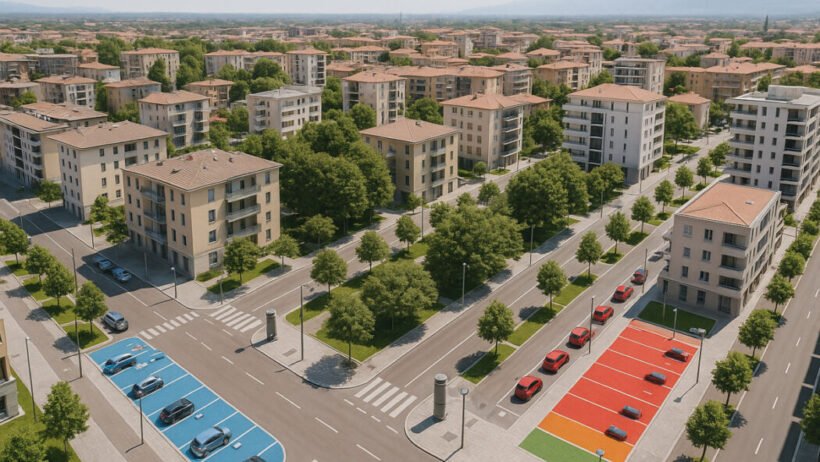Introduction – The Urban Parking Challenge in Modern Italy
Anyone who has driven through Northern Italy’s bustling cities knows the frustration. You circle the same block three times, watching precious minutes tick away as you search for that elusive parking spot. The stress builds as you realize you’re already late for your appointment.
This scenario plays out thousands of times daily across the region. Growing populations and increased vehicle ownership have created an intense competition for limited street space. What was once a minor inconvenience has evolved into a significant urban challenge affecting everyone from busy parents to local business owners.
The ripple effects extend far beyond individual frustration. Traffic congestion increases, emissions rise, and the overall quality of urban life suffers. Cities across Northern Italy have recognized that traditional approaches to parking management simply aren’t keeping pace with modern demands.
Enter Rho, a forward-thinking municipality in the Milan metropolitan area. Rather than accepting the status quo, local officials have developed an innovative solution that promises to transform how residents and visitors navigate the city. The Planimetria Zona Sud Soste Rho 2025 represents more than just technological advancement—it’s a blueprint for smarter urban living.
Understanding the Planimetria Zona Sud Soste Rho 2025
Think of the Planimetria Zona Sud Soste Rho 2025 as your personal parking assistant, but one that never sleeps and always knows exactly what’s happening across the city. This sophisticated system focuses specifically on Rho’s southern district, an area that perfectly encapsulates the modern urban challenge.
The southern zone buzzes with activity throughout the day. Residential buildings house families starting their morning routines. Commercial establishments welcome customers and receive deliveries. Public services operate at full capacity. This dynamic environment creates a complex web of parking needs that traditional static maps simply cannot address effectively.
What sets this planimetria apart is its living, breathing nature. Unlike those faded paper maps posted on street corners, this system continuously updates itself with real-time information. It tracks parking availability, monitors traffic patterns, and adjusts recommendations based on current conditions.
The beauty lies in its accessibility. Whether you prefer checking your smartphone before leaving home or consulting a physical map while walking down the street, the planimetria accommodates your preferences. This inclusive approach ensures that technological advancement doesn’t leave anyone behind.
Key Features and Visual Design Elements
The designers of the Planimetria Zona Sud Soste Rho 2025 understood a fundamental truth: complexity kills usability. Instead of overwhelming users with technical jargon and confusing symbols, they created a visual language that speaks to everyone.
The color system works intuitively. Blue zones indicate regulated parking where you’ll need to pay or display a permit. Green zones offer the holy grail of urban parking—free spaces. Orange zones cater to those quick errands where you just need fifteen minutes to grab something from the pharmacy. Red zones clearly warn you away from areas where parking will result in a ticket.
Beyond colors, carefully designed icons provide additional layers of information. A wheelchair symbol immediately identifies accessible parking spaces. Bicycle icons point toward secure bike storage. Van symbols mark loading zones where delivery drivers can work efficiently without blocking traffic.
The digital version elevates this foundation with dynamic capabilities. Real-time data streams show not just where spaces exist, but how traffic flows throughout different times of day. Morning school runs create different patterns than evening shopping trips, and the system adapts its recommendations accordingly.
Practical Applications for Different User Groups
Maria drops her eight-year-old daughter at school every morning before heading to work. Before the planimetria, this routine involved a stressful game of chance—would she find parking near the school entrance, or would she end up blocks away, making both of them late?
Now Maria checks the orange zones on her phone while having breakfast. She knows exactly where to head for short-term parking, arrives calmly, and her daughter starts each day without the anxiety that comes from rushed mornings.
Giuseppe runs a small electronics shop in the southern district. Supplier deliveries used to be a nightmare of double-parking and hurried unloading while watching for traffic police. The planimetria’s clearly marked loading zones have transformed his business operations. Suppliers know exactly where to go, deliveries happen efficiently, and Giuseppe can focus on serving customers instead of worrying about parking violations.
For commuters like Alessandro, who takes the train to Milan each day, the planimetria provides predictability in an otherwise chaotic urban environment. He can identify long-term parking areas near the station, plan his route in advance, and arrive at work refreshed rather than frazzled from a morning parking hunt.
Even weekend visitors benefit from this system. Tourists exploring Rho’s cultural attractions or families visiting local parks can navigate confidently, knowing they’ll find appropriate parking without the usual urban stress.
Technology Infrastructure and Smart City Integration
Behind the user-friendly interface lies a sophisticated network of sensors, data processors, and communication systems. These components work together seamlessly, creating a real-time picture of parking availability across the southern district.
Smart sensors embedded in parking spaces detect vehicle presence and communicate this information to central servers. Traffic monitoring systems track flow patterns and identify congestion points. Weather sensors even factor in conditions that might affect parking behavior—people tend to drive more on rainy days, for instance.
This technological foundation reflects Italy’s growing expertise in smart city solutions. Italian companies have become leaders in developing urban mobility technologies, and the Rho planimetria showcases this innovation on a practical scale.
The system doesn’t operate in isolation. It connects with public transportation schedules, traffic light timing systems, and even local event calendars. When a concert is scheduled at a nearby venue, the planimetria can anticipate increased parking demand and adjust its recommendations accordingly.
Environmental benefits emerge naturally from this optimization. When drivers spend less time circling for parking, emissions decrease. Traffic flows more smoothly, reducing stop-and-go patterns that waste fuel. The cumulative effect contributes to cleaner air and a healthier urban environment.
Economic and Social Impact on the Community
The Planimetria Zona Sud Soste Rho 2025 creates value that extends far beyond the convenience of finding parking. Local businesses report increased customer satisfaction as shopping becomes less stressful. When people can park easily, they’re more likely to browse, make purchases, and return for future visits.
Restaurant owners particularly appreciate the system’s impact. Diners no longer arrive frustrated from a difficult parking experience, and they’re more likely to linger over meals when they’re not worried about parking meters expiring. This relaxed atmosphere benefits both customers and business owners.
The social benefits are equally significant. Elderly residents who might have avoided driving due to parking difficulties now feel more confident navigating the district. Parents with young children can plan outings without the anxiety of managing strollers while searching for parking.
Accessibility improvements deserve special recognition. The planimetria’s clear identification of wheelchair-accessible spaces and nearby ramps creates a more inclusive environment. This attention to universal design principles demonstrates how smart city technology can advance social equity.
Noise pollution decreases as traffic patterns become more efficient. Residential streets experience less through-traffic from drivers searching for parking. The overall quality of life improves as the urban environment becomes more peaceful and livable.
Future Developments and Regional Expansion Potential
The success of the Planimetria Zona Sud Soste Rho 2025 has captured attention throughout Northern Italy. Municipal officials from neighboring cities regularly visit Rho to study the system and explore implementation possibilities in their own communities.
The year 2025 represents a turning point for Italian urban mobility planning. European Union initiatives promoting smart city development provide funding opportunities for similar projects. The Rho planimetria serves as a proven model that other municipalities can adapt to their specific needs.
Regional integration possibilities are particularly exciting. Imagine a seamless parking experience that extends across the entire Milan metropolitan area. Commuters could plan multi-city trips with confidence, knowing that parking information and payment systems work consistently regardless of their destination.
The technology platform’s scalability makes expansion feasible. The core systems can accommodate additional districts, cities, or even regions without requiring complete redesign. This flexibility positions the planimetria as a foundation for broader smart city initiatives.
Long-term visions include integration with autonomous vehicle systems, electric vehicle charging networks, and multimodal transportation platforms. The Planimetria Zona Sud Soste Rho 2025 isn’t just solving today’s parking problems—it’s building infrastructure for tomorrow’s mobility solutions.
As other Italian cities observe Rho’s success, the potential for nationwide adoption becomes increasingly realistic. The planimetria could become a standard feature of Italian urban life, transforming how millions of people navigate their daily routines and contributing to more sustainable, livable cities across the country.








